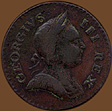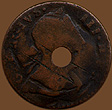New York City Imitation British Halfpence
obverse |
|
reverse |
| |||
1775 Vlack 4-75A NYC Atlee Imitation Halfpenny
Obverse: GEORGIVS . III : REX .
Reverse: BRITAN NIA . 1775
Weight: 111.7 g (7.24 grams) Diameter: 28.1 mm
Comments: The dies for this coin are thought to have been produced by James Atlee before he arrived at Machin Mills. The obverse can be identified by the colon after III. The bottom stop is smaller and slightly to the left. In GEORGIVS the O and R tip to the right while the final S is further away than the other letters and slants to the left. The upper ribbon points to the vertical of the E. This obverse was used with reverse 71C (1771) and 75A (1775).
The reverse die 75A can be distinguished in that Britannia's extended hand points to the first stroke of the A. The NIA. is low, very close to the double exergue line. The bottom end of her pole is far tot he right of the 1 in the date. This is the only Vlack imitation halfpenny reverse bearing the date 1775. Apparently the reverse die had a slight bulge at the head causing the top portion of the reverse to be pushed in slightly. This reverse was only used with obverse 4.
Provenance: Donated to Notre Dame in 1887 as part of a 2,300 item coin collection (see: The Notre Dame Scholastic, vol. 21 (September 1887) 45.
obverse |
|
reverse |
| |||
1776 Vlack 6-76A NYC Atlee Imitation Halfpenny
Obverse: GEORGIVS. III . REX .
Reverse: BRITAN [NI]A. 1776
Weight: 94.4 g (6.11 grams) Diameter: 27.8 mm
Comments: This coin was detected as a counterfeit in colonial times and had a hole drilled through it as a method of cancellation that would keep it out of circulation. During this procedure the reverse was more extensively damaged.
The dies for this coin are attributed to James Atlee before arriving at Machin's Mills. The obverse can be distinguished in that the bust has a very sloped forehead and the upper ribbon points to the center of the E while the lower ribbon points to the space between the bust and the G. Also the bust extends close to the rim of the coin under the G. Note that the R in REX is distant from the EX. The die developed a scratch from the bow knot to the R in GEORGIVS, which is not visible on this damaged example. This obverse was used with 72A (1772) and 76A (1776).
The reverse die, Vlack 76A can be distinguished here by the date 1776. Other distinguishing features are present but not easily seen on this damaged example. Note that Britannia's branch arm points between the I and the T while the branch tip ends below the first vertical stroke of the N. The bottom end of the pole is just to the left of the 1 in the date. There is a double exergue line but on this example (and most worn specimens) it appears as a thick single line. This reverse was only combined with obverse 6.
Provenance: Donated to Notre Dame in 1887 as part of a 2,300 item coin collection (see: The Notre Dame Scholastic, vol. 21 (September 1887) 45.
| Machin's Patterns | Section Contents | Machin's Mills Imitation British Coppers |
|
For viewing tips and information on optimal computer settings click
here.
For questions or comments contact Special Collections by: |



